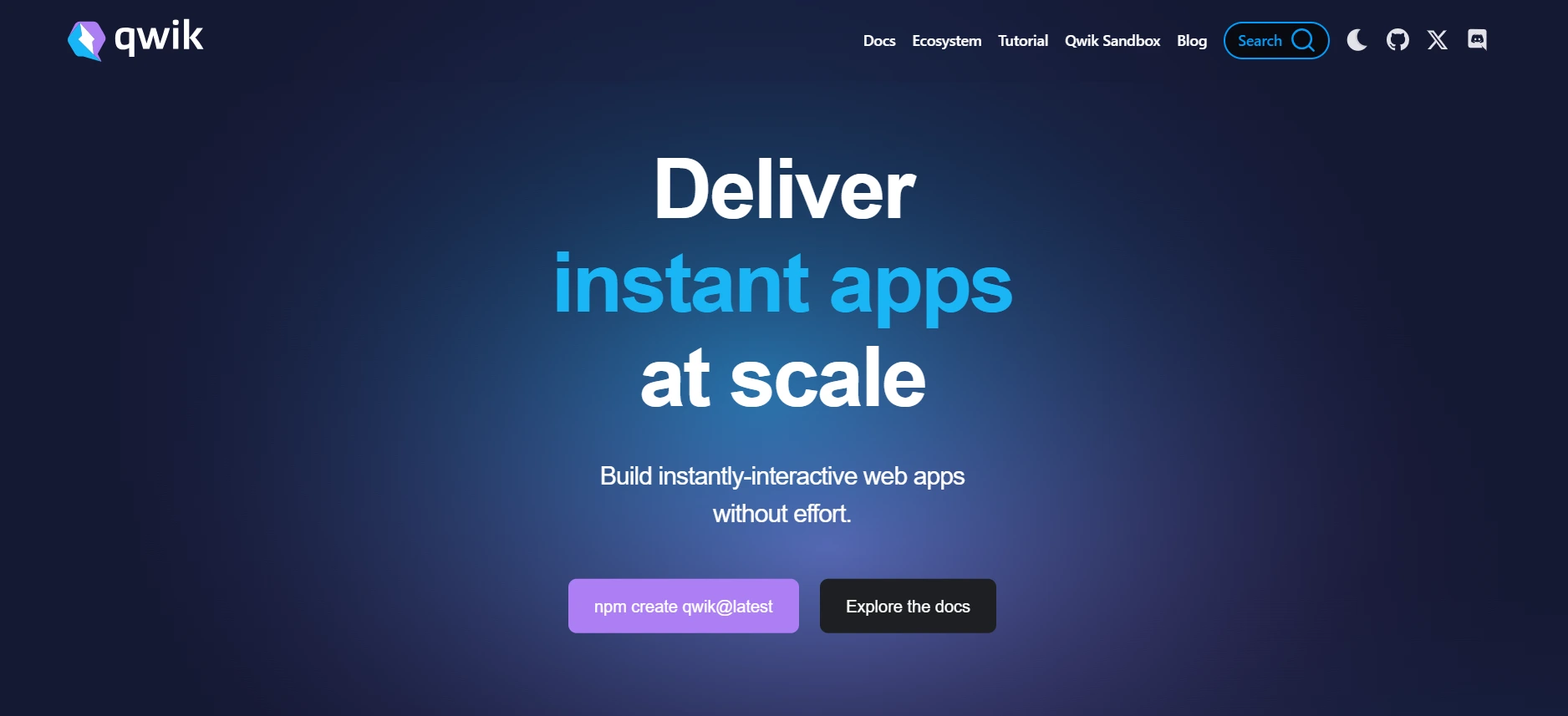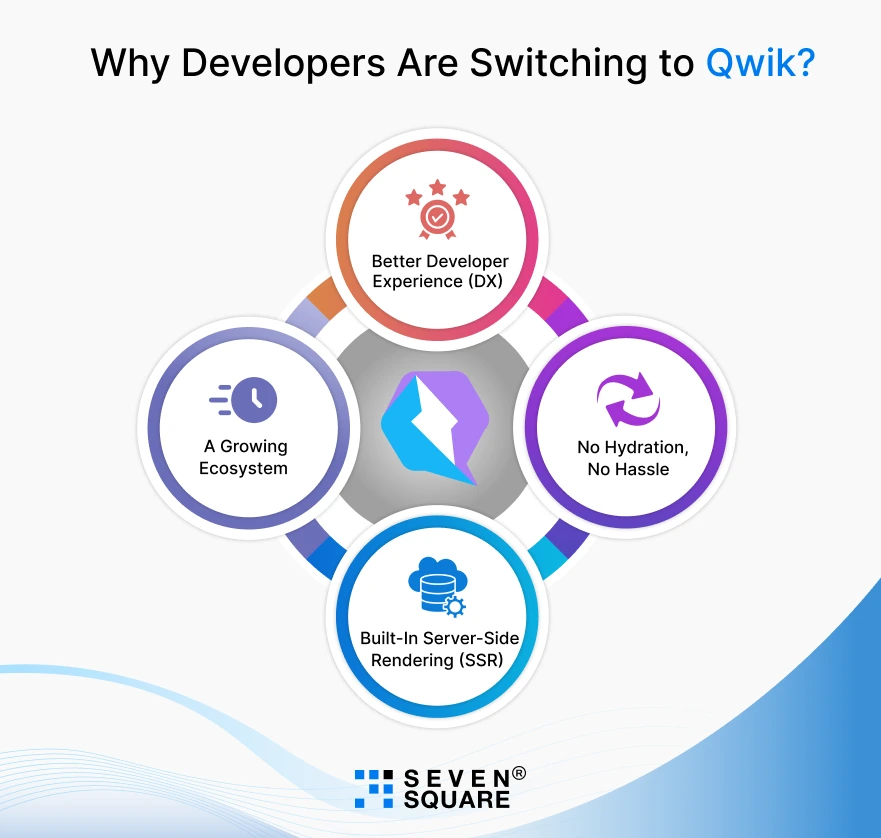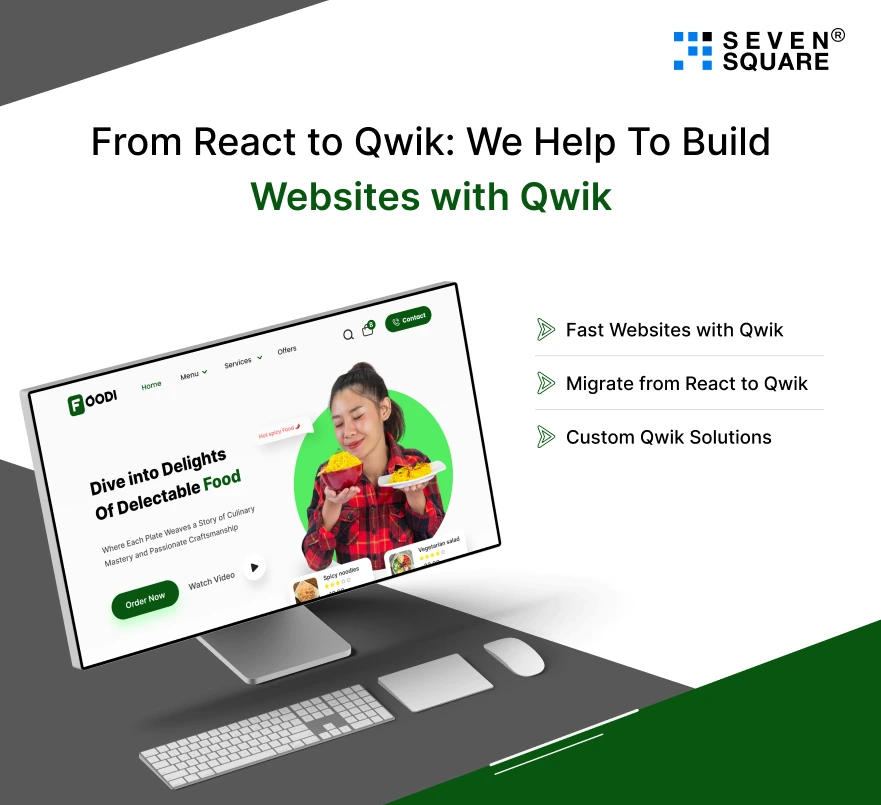Today the speed of the website and application is everything.
Whether you are running an online store, a media platform, or a startup landing page a few extra seconds of loading time can cost you users, conversions, and rankings.
That’s why the web development industry is going through a major change. Page speed and performance are important for businesses.
That’s where the Qwik framework comes into the picture. It is known as the fastest web framework available today.
Qwik is changing the game by taking a completely new approach to how websites load and run.
Unlike traditional frameworks that load everything upfront, Qwik loads only what’s needed, when it’s needed to make it fast right from the start.
Here in this blog, we will try to explain:
- What makes the Qwik framework so unique?
- A detailed comparison of Qwik vs React.
- How Qwik helps improve website performance and SEO.
Let’s understand the future of frontend development and see why Qwik can be the React killer the industry has been waiting for.
In this blog, all your doubts regarding Qwik the fastest web framework, will be solved.

Source: Google Trends
What Is the Qwik Framework?
The Qwik JavaScript framework is a new player in frontend development but it’s getting popular because of the right reasons.
It is built from the ground up for speed and scalability and Qwik introduces the concept of resumability to eliminate extra loading and improve performance.
So What is Qwik?
Qwik is a resumable JavaScript framework that doesn’t require your entire app to be loaded before it becomes interactive.
React framework needs to “hydrate” or reprocess the entire page on the client side while Qwik picks up exactly where the server left off with zero hydration.
It is possible because of its unique architecture that breaks down your app into small & independent pieces.
These pieces are only loaded when needed based on the user’s actions.
This technique is known as Qwik lazy loading, and it allows your web pages to load quickly even with complex features and dynamic content.
- Qwik Resumability: Skip hydration and reduce load time.
- Qwik Lazy Loading: Load only what’s needed & when it’s needed.
- Qwik Performance First: Built for instant interactivity.
Whether you are building an eCommerce site, a content-heavy platform, or a SaaS dashboard the Qwik framework helps to provide a responsive user experience.

Qwik vs React vs Next.js: Which One Provides Better Performance?
When it comes to building modern web apps, two questions matter most:
“How fast does it load?” and “How quickly can users interact?”
Let’s compare the Qwik framework and React to see how they perform in real-world scenarios including Qwik vs Next.js which is a popular React-based framework.
Performance Comparison: Qwik vs React vs Next.js
| Feature | Qwik | React | Next.js (React-based) |
|---|---|---|---|
| Initial Load Time | Very-fast (because of resumability). | Slower (requires hydration). | Improved but still hydrates. |
| Hydration Requirement | No hydration needed. | Full hydration required. | Partial hydration with optimization. |
| Lazy Loading | Built-in by default. | Manual setup needed. | Supported but limited. |
| Time to Interactivity (TTI) | Instant because of resumability. | Delayed & it waits for full hydration. | Moderate & it depends on setup. |
| Developer Experience (DX) | Modern & clean. | Familiar but verbose. | Better structure but still React. |
| SEO Optimization | High because of fast loading means better SEO. | Need changes for good SEO. | Better SEO out-of-the-box. |
What Does This Mean for You?
- Qwik’s performance is best because it skips hydration entirely. It resumes quickly from the server-rendered state so that users can see and interact with your app.
- With React, especially in single-page applications (SPAs), the browser has to download JavaScript, parse it, and “hydrate” the app before it becomes interactive. This can cause delays on slower devices & networks.
- Next.js is a popular React framework that improves performance and SEO but still relies on hydration and doesn’t match the speed-first architecture of Qwik.
If you want the fastest web framework with instant interactivity then Qwik is the winner.
Whether you’re comparing Qwik vs React or Qwik vs Next.js, Qwik’s resumability and lazy loading give it an advantage in real-world performance and SEO results.
Why Developers Are Switching to Qwik?

It’s not just the performance, developers are loving Qwik too.
From faster build times to simpler mental models, Qwik is quickly becoming a favorite in the dev community. Let’s understand why.
1. Better Developer Experience (DX)
- The Qwik developer experience is very smooth. Qwik keeps things simple and doesn’t require complex state management and hydration logic.
- Its resumable architecture means developers can focus on building features not fighting performance issues.
- Plus, with a clear component structure and automatic code-splitting, building scalable apps with Qwik feels flawless.
2. No Hydration, No Hassle
- Most modern frameworks rely on hydration which is a process that re-runs your JavaScript in the browser to “wake up” the page.
- Qwik takes a totally different path. It offers a powerful hydration alternative called resumability so your app can load instantly without reprocessing anything on the client side.
- This makes Qwik lighter, faster, and more efficient, especially on mobile and low-end devices.
3. Built-In Server-Side Rendering (SSR)
- Qwik provides server-side rendering (SSR) which means your pages are rendered on the server before reaching the user.
- This improves both performance and SEO to help your content rank better on Google while providing a lightning-fast experience.
- With Qwik server-side rendering, you don’t need extra libraries or plugins because everything is ready from day one.
4. A Growing Ecosystem
- Qwik is new but its community is growing fast. There is increasing support from open-source contributors, useful plugins are being built, and the core team is improving the framework.
- Developers love being part of a latest project that solves real-world performance problems and it’s only getting better with time.
Developers are switching to Qwik because it’s not just a fast framework but it’s a smarter one.
Qwik Framework Tutorial: Your First App in 3 Steps
This Qwik framework tutorial for beginners will help you to build a basic Qwik app.
You can also understand how Qwik’s resumability feature works behind the scenes.
Step 1: Set Up Your Project
You can start with Qwik in minutes using their official starter template.
npm create qwik@latest
Copied!
This command will prompt you to choose a starter like a basic app or Qwik + Tailwind setup. Choose one, and Qwik will set everything up for you.
Step 2: Explore the File Structure
Once your app is created, you can see a clean and simple folder structure:
- /src/routes/: Pages and routes
- /src/components/: Reusable UI components
- /public/: Static files like images
- qwik.config.ts: Qwik configuration
Qwik uses a file-based routing system like Next.js to easily manage pages and paths.
Step 3: Build Your First Component
Create a simple Qwik component in /src/components/HelloQwik.tsx:
import { component$ } from '@builder.io/qwik';
export const HelloQwik = component$(() => {
return <h1> Hello from Qwik! </h1>
});
Copied!
Use it in your route file:
import { HelloQwik } from '../components/HelloQwik';
export default component$(() => {
return (
<div>
<HelloQwik/>
</div>
);
});
Copied!
That’s it, you just built a resumable & lazy-loaded component.
Learn about Qwik Playground
From React to Qwik: We Help To Build Websites with Qwik

As a leading custom software development company, we help startups, enterprises, and agencies to build superfast & future-ready websites using the Qwik framework.
Learn more to build Autonomous AI Agents.
1. Fast Websites with Qwik
- We specialize in building high-performance websites with Qwik JavaScript framework.
- Our team ensures that users can fast load times and smooth interactions even on low-end devices.
2. Migrate from React to Qwik
- Want to upgrade your site without risking downtime?
- Get our smooth React to Qwik migration services to ensure your transition is smooth, stable, and SEO-friendly.
3. Custom Qwik Solutions
- From eCommerce platforms to SaaS apps, media portals, and enterprise software, we create custom Qwik solutions that grows with your business.
Want to Build a Web, the Qwik Way? Contact Us Today!
FAQs
- React depends upon hydration (loading JavaScript after HTML renders) while Qwik skips hydration with its resumability approach.
- This allows pages to load faster and become interactive quickly & gives Qwik a benefit over React.
- Qwik vs Next.js comes down to performance.
- Next.js still uses hydration whereas Qwik avoids it completely.
- If speed and SEO are your priorities then Qwik may outperform Next.js for your use case.
- Qwik is beginner-friendly that uses familiar JSX syntax.
- Plus, its modular structure and documentation make it easy to get started if you’ve used React or similar frameworks before.
- Yes, Qwik is maintained and used in production by companies like Builder.io.
- It has a growing ecosystem, GitHub community, and is ready for commercial use in real-world apps.